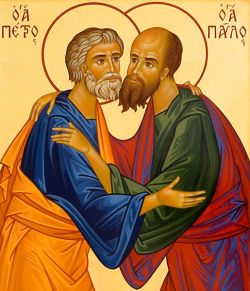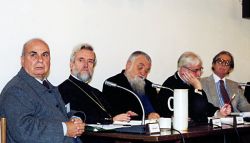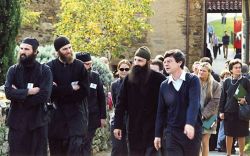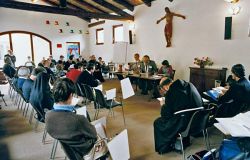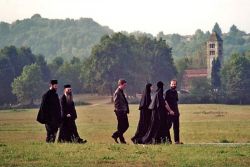Introduction to the Orthodox conferences
In Search of Shared Spiritual Sources: International Ecumenical Conferences on Orthodox Spirituality
The Experience of a Fraternal Encounter
Since 1993 for more than twenty years now, the Monastery of Bose in Italy, has been a meeting place for Christians from East and West wishing to discuss aspects of Christian spirituality. They are Christians belonging to the Orthodox, Reformed, Roman Catholic and Anglican churches, and these encounters have been and will continue to be essentially an occasion for listening to each other. “You have seen your brother, you have seen God” is a frequently quoted saying of the desert Fathers. One could paraphrase it and say “You have heard your brother (i.e. you are able to listen to him), you have heard God (i.e. you are then able to make room in your life for the word of God)”, for indeed, how can we say we love (and therefore we listen to, serve and follow) God whom we do not see, if we do not love our brother whom we do see? (1 Jn 5:20).
It is precisely this wish to listen to one’s neighbour – a foremost prerequisite for any dialogue – that motivates and drives these conferences on the history of Christian spirituality. They are intended as a service to all churches, as an occasion for joint study and mutual encounters, for investigating the spiritual wealth of the Eastern Church, those “authentic theological traditions of the Eastern Christians” which, as the II Vatican Council authoritatively notes, are “rooted in the Holy Scriptures … expressed in liturgical life … nourished by the living Apostolic tradition, by the writings of Fathers and ascetics from the East … aspiring to a correct approach to life , indeed to the full contemplation of Christian truth”.
The participation in these conferences of Orthodox, Roman Catholic and Reformed Christians underscores the precise practice of these encounters: let the other define himself and bring testimony of what he holds most dear. What lies at the heart of each specific Christian tradition is its own history of holiness, where the gifts of the Holy Spirit are manifest and become incarnate in a concrete manner and in a particular path, and through Grace come to bring sense and hope to all churches and to all mankind.
The initiative, made possible through the cooperation of Professor Nina Kautschwili of Bergamo University, soon came under the patronage of the Patriarchate of Moscow, thanks to the interest shown by Metropolitan Kyril of Smolensk and Kaliningrad, and later on by Ecumenical Patriarch Bartholomeos I. Ever since their inception, the Pontifical Council for Christian Unity welcomed these conferences and assured its efficient cooperation. Gradually, representatives of all Churches, Orthodox and Protestant, came to this initial Italian-Russian initiative, along with scholars and church personalities from other countries, such as France, Germany, Belgium, Great Britain, Greece, Romania, Bulgaria, Serbia, Czech Republic, Norway, Ukraine, Belarus, United States and Canada.
From the eighth conference onwards, the Russian section was flanked by a section on Byzantine spirituality. This joint approach proved to be particularly fruitful on account of the numerous cultural, spiritual, institutional inter-relationships which mark the history of Byzantine and Slav civilizations, and an occasion for a fraternal and open encounter on the actual state and vitality of these inter-relationships in the context present day ecumenical relations. Topics dealt with to this day combine the rich spiritual heritage of the Russian tradition with the study of Byzantine and Greek Fathers and of the Church in the first millennium: St Nikodemos the Athonite and the Philokalia / Forms of Russian Holiness (2000); St John Climacus and Mount Sinai / Ways of Russian Monasticism (2001); St Symeon the New Theologian and Constantinopolitan Monasticism / The Elders of Optina Monastery
(2002); The Desert of Gaza: Sts Barsanuphius, John and Dorotheos / The Great Moscow Council of 1917-1918 (2003); St Athanasius the Athonite and Monasticism on Mount Athos / The Jesus Prayer in 19th Century Russian Spirituality (2004); St John Damascene. A Church Father at the Emergence of Islam / Andreij Rublev and the Russian Icon (2005); St Nicolas Cabasilas and the Divine Liturgy / The Missionary Work of the Russian Orthodox Church (2006).The fifteenth edition brought with it a new formula: the two sections (the Byzantine and the Russian) centered around the same theme, with the intention to trace a common itinerary of the main aspects of the spiritual life that are at the core of the Orthodox tradition, whatever its peculiar culture. A fruitful confrontation with the western spiritual tradition and with questions posed by our contemporaries was also not forgotten. So far the following conferences have been organized in this manner: The transfigured Christ in the Orthodox spiritual tradition (2007); Spiritual paternity in the Orthodox tradition (2008); Spiritual struggle in the Orthodox tradition (2009).
Conference Proceedings are published annually, often translated in many languages, providing continuity for encounters and mutual knowledge, and at the same time broadening the horizons of all those who feel the imperative importance of a renewed approach to the sources of Christian spirituality. Let us now see why this search for common sources is so essential.
- 1
- 2
